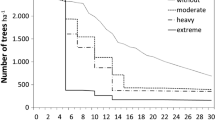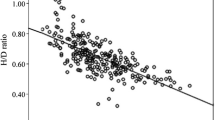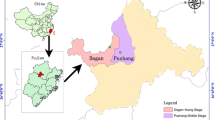Abstract
To evaluate the effect of thinning on a mature coastal Pinus thunbergii Parlat. forest in Hokkaido, northern Japan, we established four study plots with different thinning intensities (control and 20, 40, and 60 % thinned at individual base; each 20 m × 20 m) and monitored them for 10 years. Radial growth of individual trees in the 60 % thinned plot was significantly greater than that in the other plots, whereas height growth in the 60 % thinned plot was significantly lower than in the other plots. Applying the height growth contribution index, which represents the trade-off between relative height growth rate and relative diameter growth rate, revealed that individual trees in the control and weakly (20 and 40 %) thinned plots had invested more in height growth compared to trees in the 60 % thinned plot. Though higher trunk slenderness value (>80) indicates higher susceptibility to meteorological disturbance such as wind storm and heavy snow, trunk slenderness in the control and the weakly thinned plots increased significantly compared to that in the 60 % thinned plot. In this study, 44.3 % of trees in the control plot had trunk slenderness values >80 over a period of 10 years. The number of trees with trunk slenderness values >80 also increased in the weakly thinned plots. In contrast, no increase was observed in the 60 % thinned plot. In Japan, the thinning intensity is legally supposed to be <35 % of stand volume, which is not enough to improve tree architecture in terms of trunk slenderness.




Similar content being viewed by others
References
Anderson D, Burnham K (2001) Commentary on models in ecology. Bull Ecol Soc Am 82:160–161
Cochran PH, Barrett JW (1993) Long-term response of planted ponderosa pine to thinning in Oregon’s Blue Mountains. West J Appl For 8:126–132
Crawley MJ (2005) Statistics: an introduction using R. Wiley, Chichester
Cremer KW, Borough CJ, McKinnel FH, Carter PR (1982) Effects of stocking and thinning on wind damage in plantations. NZ J For Sci 12:244–268
Esashi Folk Tale Research Group (1993) Folk tale in Esashi. Esashi Folk Tale Research Group, Esashi (in Japanese; English title was translated by authors)
Forestry Agency (ed) (1992) Guidebook of technique for forest conservation. Jpn For Conserv Assoc (in Japanese; English title was translated by authors)
Hibbs DE, Emmingham WH, Bondi MC (1995) Responses of red alder to thinning. West J Appl For 10:17–23
Kaneko T (2000) Growth classification of the Pinus thunbergii in Akita and Tenno coasts. Tohoku J For Sci 5:91–96 (in Japanese)
Kaneko T, Ishida H, Kanezawa M (2000) Crown snow damages of Pinus thunbergii in south coast of Akita prefecture. Tohoku J For Sci 5:97–100 (in Japanese)
Kawaguchi S (2001) Present condition of the foredunes and coastal protection forests in Kujyukuri-beach, Chiba prefecture. Sand Dune Res 48:30–37 (in Japanese)
Kawasaki Y, Tanaka K (1983) Fundamental studies on the tending and regeneration of the coastal sand-dune fixation forest. (1) Stand density control and stand structure. Sand Dune Res 30:233–247 (in Japanese with English summary)
Kikuzawa K (1978) Yield-density diagram of natural deciduous hardwood forest stands in Hokkaido. J For Res 60:56–63 (in Japanese with English summary)
Kikuzawa K (1983) Yield-density diagram: compactness index for stands and stand components. For Ecol Manag 7:1–10
Kozlowski TT, Kramer PJ, Pallardy SG (1991) The physiological ecology of woody plants. Academic, San Diego
Kunisaki T (2005) Pattern of snow accretion damage in an old sugi (Cryptomeria japonica D. Don) plantation at the base of Mt. Iwate, northern Japan. J Jpn For Soc 87:426–429 (in Japanese with English summary)
Lanner RM (1985) On the insensitivity of height growth to spacing. For Ecol Manag 13:143–148
Martín-Alcón A, González-Olabarria JR, Coll L (2010) Wind and snow damage in the Pyrenees pine forests: effect of stand attributes and location. Silva Fenn 44:399–410
Masaka K, Sato H, Kon H (2007) Effects of thinning on the coastal black pine forests with different ages. Trans Meet Hokkaido Branch Jpn For Soc 55:32–34 (in Japanese)
Masaka K, Sato H, Torita H, Kon H, Akashi N (2009) Basic study for density control of densely planted protected forest composed of Acer pictum ssp. mono (Maxim.) Ohasi, Larix gmelinii var. japonica Pilger or Quercus dentata Thunb. in Hokkaido, northern Japan. Bull Hokkaido For Res 46:85–116 (in Japanese with English summary)
McCarthy MA (2007) Bayesian methods for ecology. Cambridge University Press, New York
Nykänen M-L, Peltola H, Quine CP, Kellomäki S, Broadgate M (1997) Factors affecting snow damage of trees with particular reference to European conditions. Silva Fenn 31:193–213
Oda T (1992) Tree density control of Pinus thunbergii stands. In: Murai H, Ishikawa Y, Endo H, Tadaki R (eds) The coastal forests in Japan—its multiple functions and use. Soft Science, Tokyo, pp 402–405 (English title was translated by authors)
Petty JA, Swain C (1985) Factors influencing stem breakage of conifers in high winds. Forestry 58:75–85
Petty JA, Worrell R (1981) Stability of coniferous tree stems in relation to damage by snow. Forestry 54:115–128
Powers RF, Oliver WW (1970) Snow breakage in a pole-sized ponderosa pine plantation… more damage at high stand-densities. USDA Forest Service, Research Note PSW-218
R Development Core Team (2007) R: a language and environment for statistical computing. R Foundation for Statistical Computing, Vienna, Austria. Online: http://www.R-project.org (2012/06/02)
Sumida A, Ito H, Isagi Y (1997) Trade-off between height growth and stem diameter growth for an evergreen Oak, Quercus glauca, in a mixed hardwood forest. Funct Ecol 11:300–309
Suzuki S (1983) History of coastal wind-shelter belts in Noshiro. Online: http://www.shirakami.or.jp/˜pinewood/book/sabourin_rekishi.pdf (2012/06/02) (in Japanese; English title was translated by authors)
Torita H (2005) Analytical case study of Japanese larch forest damaged by glaze in Hidaka Hokkaido in February, 2004. J Jpn For Soc 87:354–357 (in Japanese with English summary)
Torita H (2006) Analyses of wind damage caused by typhoon 200221 at shelterbelts in Tokachi, Hokkaido. J Jpn For Soc 88:489–495 (in Japanese with English summary)
Torita H, Takeda K (2007) Relationship between stand structure and damage rate in Japanese larch forests damaged by glaze. J Jpn For Soc 89:39–44 (in Japanese with English summary)
Wonn HT, O’Hara KL (2001) Height:diameter ratios and stability relationships for four northern Rocky Mountain tree species. West J Appl For 16:87–94
Young TP, Hubbell SP (1991) Crown asymmetry, treefall, and repeat disturbance of broad-leaved forest gaps. Ecology 72:1464–1471
Zhang S, Burkhart HE, Amatis RL (1997) The influence of thinning on tree height and diameter relationships in loblolly pine plantations. South J Appl For 21:199–205
Zuur AF, Ieno EN, Walker NJ, Saveliev AA, Smith GM (2009) Mixed effects models and extensions in ecology with R. Springer, New York
Acknowledgments
We are grateful to the staff of Hiyama Sub-prefectural Office for their support in setting up the study plots; to Ikuko Tanahashi, Masazumi Honda, Wataru Anpo and Yūki Saitoh for their help in field survey.
Author information
Authors and Affiliations
Corresponding author
About this article
Cite this article
Masaka, K., Sato, H., Torita, H. et al. Thinning effect on height and radial growth of Pinus thunbergii Parlat. trees with special reference to trunk slenderness in a matured coastal forest in Hokkaido, Japan. J For Res 18, 475–481 (2013). https://doi.org/10.1007/s10310-012-0373-y
Received:
Accepted:
Published:
Issue Date:
DOI: https://doi.org/10.1007/s10310-012-0373-y




